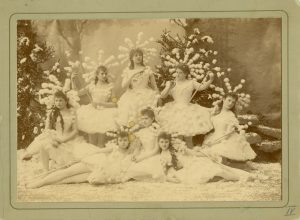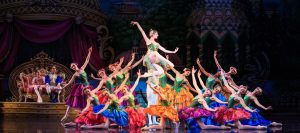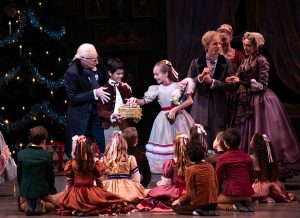‘The Nutcracker’ History and What We Can Learn From It
The Royal Ballet in Peter Wright’s interpretation of The Nutcracker (2018) (Photo via ‘Why The Royal Ballet love preforming The Nutcracker’ on YouTube)
December 25, 2022
‘Tis the season for our favorite holiday traditions. Starting Dec. 1, radios are tuned to holiday channels, homes are decorated with lights and nutcrackers, and Tchaikovsky is played in shopping malls. Everyone enjoys “The Nutcracker” in some way every winter, so why not learn a little history of the story and ballet that started it all?
Origin Story and Interpretations
The story is a simple one. A family hosts a holiday party where a young girl is given a nutcracker doll. The little girl’s brother breaks the doll and the children are sent to bed. Midnight strikes and with that, the magic begins. The little girl encounters mice, soldiers and snowflakes (oh my!) as she and her now come-to-life nutcracker make the voyage to the Land of Sweets, where an assortment of dancing sweets greets them.
You may have noticed my intentional calling of the ballet’s young protagonist “little girl,” as even though the story of the Nutcracker has stayed remotely the same over the decades, many details and flourishes of the ballet have been up to much interpretation — beginning with the young protagonist’s name. Below I break down some key differences between the most popular productions of “The Nutcracker.”
Marius Petipa and Lev Ivanov

The first ballet interpretation of “The Nutcracker and the Mouse King” written by E.T.A. Hoffman and “The Tale of the Nutcracker” by Alexandre Dumas was choreographed by Marius Petipa and Lev Ivanov in collaboration with Pyotr Ilyich Tchaikovsky. The Petipa version of “The Nutcracker” names the young protagonist Marie and she has a very simple role in the ballet, mainly dancing with other children in Act I.
Some later productions of “The Nutcracker,” such as Peter Wright’s version danced by the Royal Ballet in London, cast an adult professional dancer as the main role, now named Clara. Wright’s version keeps most of the same choreography as the Petipa and Ivanov version, except that the older Clara dances with the sweets in Act II.
Willam Christensen

In 1933 Willam Christensen, a Utah native, founded the San Francisco Ballet in San Francisco, California. With a new company came the first production of “The Nutcracker” to be performed in the United States. In 1963 Christensen returned to Utah and founded Ballet West with Glenn Walker Wallace in Salt Lake City, Utah.
BW has been performing Christensen’s “The Nutcracker” since that year. Christensen’s production uses a newer interpretation that differs from the original or more classical productions. The Nutcracker role is danced by an adult company member while Clara is a young girl, wearing pointe shoes in Act II. The decision to portray Clara and the Nutcracker Prince as older characters lessens the youthfulness and magic of the original, in my opinion. Clara and the Nutcracker Prince are the main characters of Act I, but Act II is more effective when it introduces the audience and Clara to older dancers as the sweets. This production also has more “pas de deux,” or partner dances, in the Snowflake Waltz, Coffee from Arabia dance and Waltz of the Flowers scenes. Although beautiful, at times partner work can overcomplicate the dance. Sometimes dance is more effective as less is more.
George Balanchine

George Balanchine’s “The Nutcracker” first premiered at the City Center of Music and Drama in New York in 1954. Though born in Russia, Balanchine is considered the father of American ballet, creating the American style using great musicality and energy, high jumps and speed. Balanchine’s Nutcracker is considered the definitive Nutcracker production and is performed nationally. His production stays close to the original Nutcracker story; the protagonist is named Marie but the show features new classical choreography. The New York City Ballet hires about 125 children from the company’s affiliate school, The School of American Ballet, in two alternating casts to play the roles of Marie, the Nutcracker prince, angels and more. In Balanchine’s production, the corps de ballet, the lowest and largest rank of dancers in the company, perform the Snowflake Waltz and are the flowers in The Waltz of the Flowers. The Dewdrop and Coffee from Arabia are both solos, unlike Christensen’s version. Balanchine’s nutcracker has been adapted for two films — the first one, recorded in 1993, stars Macaulay Culkin as the Nutcracker Prince. Bet you didn’t know that!
At the end of the day, it doesn’t matter if Dewdrop is a pas de deux or solo, it matters that audiences have access to the story of a little girl saving herself from the evil mouse king and can enjoy the diverse ensemble of people and dances in the land of sweets. The Nutcracker is a celebration of culture and differentness that can bring us all together and remind us of how important kindness is, especially in the holiday season. If this will be your first or hundredth time seeing the Nutcracker, go out and explore different productions of the Nutcracker, and maybe add it to your holiday traditions.








